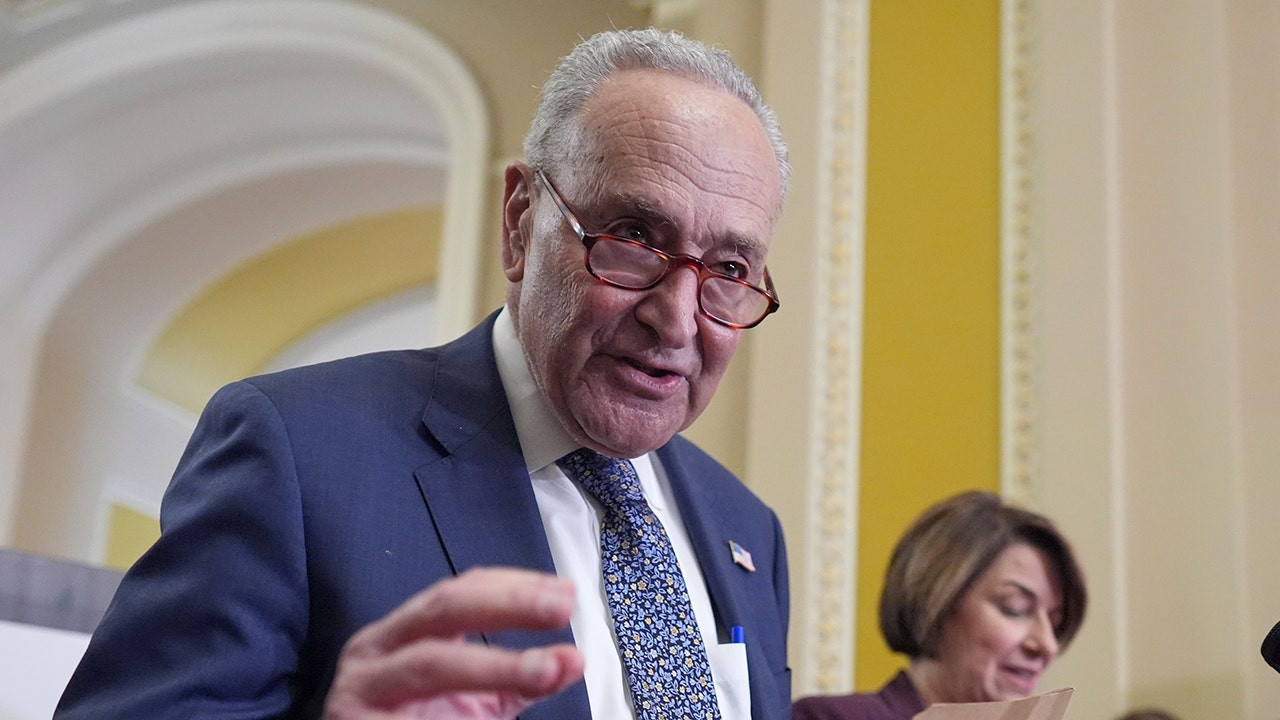Finance
US colleges are cutting majors and slashing programs after years of putting it off

Christina Westman dreamed of working with Parkinson’s disease and stroke patients as a music therapist when she started studying at St. Cloud State University.
But her schooling was upended in May when administrators at the Minnesota college announced a plan to eliminate its music department as it slashes 42 degree programs and 50 minors.
It’s part of a wave of program cuts in recent months, as U.S. colleges large and small try to make ends meet. Among their budget challenges: Federal COVID relief money is now gone, operational costs are rising and fewer high school graduates are going straight to college.
The cuts mean more than just savings, or even job losses. Often, they create turmoil for students who chose a campus because of certain degree programs and then wrote checks or signed up for student loans.
“For me, it’s really been anxiety-ridden,” said Westman, 23, as she began the effort that ultimately led her to transfer to Augsburg University in Minneapolis. “It’s just the fear of the unknown.”
At St. Cloud State, most students will be able to finish their degrees before cuts kick in, but Westman’s music therapy major was a new one that hadn’t officially started. She has spent the past three months in a mad dash to find work in a new city and sublet her apartment in St. Cloud after she had already signed a lease. She was moving into her new apartment Friday.
For years, many colleges held off making cuts, said Larry Lee, who was acting president of St. Cloud State but left last month to lead Blackburn College in Illinois.
College enrollment declined during the pandemic, but officials hoped the figures would recover to pre-COVID levels and had used federal relief money to prop up their budgets in the meantime, he said.
“They were holding on, holding on,” Lee said, noting colleges must now face their new reality.
Higher education made up some ground last fall and in the spring semester, largely as community college enrollment began to rebound, National Student Clearinghouse Research Center data showed.
But the trend for four-year colleges remains worrisome. Even without growing concerns about the cost of college and the long-term burden of student debt, the pool of young adults is shrinking.
Birth rates fell during the Great Recession of 2007 to 2009 and never recovered. Now those smaller classes are preparing to graduate and head off to college.
“It’s very difficult math to overcome,” said Patrick Lane, vice president at the Western Interstate Commission for Higher Education, a leading authority on student demographics.
Complicating the situation: the federal government’s chaotic overhaul of its financial aid application. Millions of students entered summer break still wondering where they were going to college this fall and how they would pay for it. With jobs still plentiful, although not as much as last year, some experts fear students won’t bother to enroll at all.
“This year going into next fall, it’s going to be bad,” said Katharine Meyer, a fellow in the Governance Studies program for the Brown Center on Education Policy at the nonprofit Brookings Institution. “I think a lot of colleges are really concerned they’re not going to make their enrollment targets.”
Many colleges like St. Cloud State already had started plowing through their budget reserves. The university’s enrollment rose to around 18,300 students in fall 2020 before steadily falling to about 10,000 students in fall 2023.
St. Cloud State’s student population has now stabilized, Lee said, but spending was far too high for the reduced number of students. The college’s budget shortfall totaled $32 million over the past two years, forcing the sweeping cuts.
Some colleges have taken more extreme steps, closing their doors. That happened at the 1,000-student Birmingham-Southern College in Alabama, the 900-student Fontbonne University in Missouri, the 350-student Wells College in New York and the 220-student Goddard College in Vermont.
Cuts, however, appear to be more commonplace. Two of North Carolina’s public universities got the green light last month to eliminate more than a dozen degree programs ranging from ancient Mediterranean studies to physics.
Arkansas State University announced last fall it was phasing out nine programs. Three of the 64 colleges in the State University of New York system have cut programs amid low enrollment and budget woes.
Other schools slashing and phasing out programs include West Virginia University, Drake University in Iowa, the University of Nebraska campus in Kearney, North Dakota State University and, on the other side of the state, Dickinson State University.
Experts say it’s just the beginning. Even schools that aren’t immediately making cuts are reviewing their degree offerings. At Pennsylvania State University, officials are looking for duplicative and under-enrolled academic programs as the number of students shrinks at its branch campuses.
Particularly affected are students in smaller programs and those in the humanities, which now graduate a smaller share of students than 15 years ago.
“It’s a humanitarian disaster for all of the faculty and staff involved, not to mention the students who want to pursue this stuff,” said Bryan Alexander, a Georgetown University senior scholar who has written on higher education. “It’s an open question to what extent colleges and universities can cut their way to sustainability.”
For Terry Vermillion, who just retired after 34 years as a music professor at St. Cloud State, the cuts are hard to watch. The nation’s music programs took a hit during the pandemic, he said, with Zoom band nothing short of “disastrous” for many public school programs.
“We were just unable to really effectively teach music online, so there’s a gap,” he said. “And, you know, we’re just starting to come out of that gap and we’re just starting to rebound a little bit. And then the cuts are coming.”
For St. Cloud State music majors such as Lilly Rhodes, the biggest fear is what will happen as the program is phased out. New students won’t be admitted to the department and her professors will look for new jobs.
“When you suspend the whole music department, it’s awfully difficult to keep ensembles alive,” she said. “There’s no musicians coming in, so when our seniors graduate, they go on, and our ensembles just keep getting smaller and smaller.
“It’s a little difficult to keep going if it’s like this,” she said.
___
The Associated Press’ education coverage receives financial support from multiple private foundations. AP is solely responsible for all content. Find AP’s standards for working with philanthropies, a list of supporters and funded coverage areas at AP.org.

Finance
Why Tipalti’s AI-Driven Finance Platform is a Strategic Growth Asset in a Post-Brexit World

In a global economy increasingly defined by regulatory complexity and automation-driven efficiency, Tipalti emerges as a titan of fintech innovation. Valued at $8.3 billion following its Series F funding round in 2023 and backed by JPMorgan Chase, this AI-driven finance platform is not just scaling rapidly—it’s redefining how businesses navigate the labyrinth of global payments, compliance, and scalability. With a focus on automating underpenetrated markets and leveraging the UK’s post-Brexit tech ecosystem, Tipalti is primed to capitalize on a $300+ billion addressable market of enterprises still reliant on manual financial workflows. Here’s why investors should pay attention.
Scalability Through AI Automation: The Engine of Growth
Tipalti’s core platform automates end-to-end financial workflows—from supplier management and VAT compliance to multi-currency payments—processing over $30 billion annually for 2,000+ clients. Its AI engine reduces operational bottlenecks by 90% for high-growth firms, enabling companies to scale without hiring armies of accountants.
The scalability advantage is clear: shows a 150% increase, outpacing competitors like Versapay and Billtrust. As SMEs and mid-sized firms seek to expand into global markets, Tipalti’s platform becomes a necessity, not a luxury.
Regulatory Compliance as a Competitive Edge
Global financial regulations are a minefield. Post-Brexit, UK firms face dual EU and domestic compliance requirements, while US businesses grapple with OFAC sanctions and IRS scrutiny. Tipalti’s AI-driven compliance module automates VAT calculations, tax reporting, and anti-money laundering checks across 200+ countries—a critical feature for multinational firms.
JPMorgan’s partnership here is pivotal. The bank’s infrastructure powers Tipalti’s cross-border payments, while its risk management systems underpin compliance. This synergy is reflected in , which hit $12 billion—a stark reminder of the cost of manual errors. Tipalti’s clients avoid these risks entirely.
The UK Tech Ecosystem: Post-Brexit Resilience & Talent
The UK’s fintech sector has thrived post-Brexit, thanks to its world-class talent pool and banking infrastructure. Tipalti’s London office—housed in a tech hub near the Bank of England—employs 300+ engineers and compliance experts, leveraging the UK’s post-Brexit regulatory sandboxing and access to EU markets.
The ecosystem’s resilience is quantifiable: shows a 220% increase in funding, with London now rivaling San Francisco as a fintech capital. Tipalti’s expansion into Europe is further fueled by its partnership with Statement, a UK-based acquisition in 2025 that strengthened its payroll and tax software offerings.
Market Opportunity: Capturing the $300B+ Under-Automated Enterprise Market
The global market for automated financial workflows—spanning payments, compliance, and procurement—stands at $350 billion and is growing at 12% annually. Yet, 60% of SMEs still use spreadsheets for invoicing and manual processes for VAT compliance. Tipalti’s AI platform directly targets this inefficiency, offering a 70% cost reduction in accounts payable operations.
With a valuation trajectory that rose from $2 billion (2020) to $8.3 billion (2023), Tipalti is on course to become a decacorn (
Investment Thesis: IPO Potential & Sector Dominance
Tipalti is a buy now, hold forever play. Key catalysts include:
1. IPO Readiness: With $737 million raised to date and a $300M+ revenue run rate (estimated), Tipalti is likely preparing for an IPO in 2025–2026.
2. Competitive Moat: Its AI compliance engine and JPMorgan partnership create switching costs that deter competitors.
3. UK-Driven Resilience: London’s talent and regulatory agility reduce geopolitical risks, making Tipalti’s UK operations a shield against global instability.
Final Analysis: A Fintech Leader with Global Ambition
Tipalti’s combination of AI scalability, compliance expertise, and strategic UK positioning makes it a rare investment opportunity. While risks include regulatory headwinds and competition, the company’s valuation growth and JPMorgan’s backing signal confidence in its long-term vision. For investors seeking exposure to fintech’s next phase—where automation meets global resilience—Tipalti is a cornerstone play.
Recommendation: Invest in Tipalti ahead of its likely IPO. Its dominance in automating underpenetrated markets and post-Brexit UK tech resilience position it to outperform peers in the years ahead.
Risks include regulatory changes, tech execution failures, and market saturation. Consult a financial advisor before investing.
Finance
Joint Finance Committee votes to release $9 million for literacy funding during late-night hearing

We recognize you are attempting to access this website from a country belonging to the European Economic Area (EEA) including the EU which
enforces the General Data Protection Regulation (GDPR) and therefore access cannot be granted at this time.
For any issues, contact news@wkow.com or call 608-274-1234.
Finance
Retallick named next associate dean for personnel and finance, Iles to step in as interim AGEDS chair

AMES, Iowa – With a passion for leading others and thinking strategically about where the college and its departments and programs should go, Mike Retallick has been selected to serve as the next associate dean for personnel and finance for the College of Agriculture and Life Sciences (CALS) at Iowa State University, effective July 1.
Retallick currently serves as chair of the Department of Agricultural Education and Studies (AGEDS), a position he’s held since 2016. He will continue serving in this role, in addition to being the new associate dean, until August, when Jeff Iles, professor of horticulture and previous chair of the Department of Horticulture, will step in as interim chair of the AGEDS department.
“Dr. Retallick has done a tremendous job of leading the Department of Agricultural Education and Studies, is a great team player and totally embraces the community and land-grant spirit of the college. We are excited to have Mike in this role as associate dean for personnel and finance to support our faculty and staff, to enable our students and to achieve all of our missions and purposes,” said Daniel J. Robison, endowed dean’s chair in the College of Agriculture and Life Sciences. “We are grateful for Dr. Iles stepping up to lead the Department of Agricultural Education and Studies as interim chair this fall. Jeff did outstanding work as the long-serving chair of the Department of Horticulture, and he’ll bring that experience and skill to this interim role.”

A search for a new chair for the AGEDS department will begin soon.
Retallick has been at Iowa State since 2001, starting as an academic advisor then assistant, associate and professor in the AGEDS department. He also previously served as the director and is now the interim director of the CALS Science with Practice program.
He has served the college and university in many capacities as well, through involvement in various boards and committees, including the Agricultural Endowment Board, CALS Online Learning Taskforce, Micro-credential Taskforce, Provost’s Chairs Cabinet and Faculty Work/Life Advisory Committee.
“This role is instrumental to the success and advancement of the college,” Retallick said. “I’m humbled by the opportunity to join the dean’s leadership team and look forward to working across the college’s departments and units to advance the great work we do in teaching, research and Extension and Outreach, all of which are enabled through personnel and finance.”
Retallick has a bachelor’s degree in agricultural education from the University of Wisconsin – Platteville and a master of agribusiness degree from Kansas State University. He earned his doctoral degree in agricultural education from Iowa State.
The position of associate dean for personnel and finance is fairly new in CALS. Ruth MacDonald currently serves in this role and will do so until June 30. After that, she will continue as the interim chair of the Department of Food Science and Human Nutrition.
“We are so appreciative of the great work and impacts our college’s first Associate Dean for Personnel and Finance Ruth MacDonald has done these past four years with staff in the CALS budget and finance office and leadership all across the college,” Robison said.
Contacts
Mike Retallick, Agricultural Education and Studies, 515-294-4810, msr@iastate.edu
Whitney Baxter, Agriculture and Life Sciences Communications, 515-294-2314, wjsager@iastate.edu
-

 Business1 week ago
Business1 week agoDriverless disruption: Tech titans gird for robotaxi wars with new factory and territories
-

 Business1 week ago
Business1 week agoProtesters are chasing federal agents out of L.A. County hotels: ‘A small victory’
-

 Technology1 week ago
Technology1 week agoMeta held talks to buy Thinking Machines, Perplexity, and Safe Superintelligence
-

 Technology1 week ago
Technology1 week agoSpaceX Starship explodes again, this time on the ground
-

 Technology1 week ago
Technology1 week agoSamsung’s Galaxy Watch 7 has returned to its lowest-ever price
-

 Movie Reviews1 week ago
Movie Reviews1 week ago‘8 Vasantalu’ movie review: Phanindra Narsetti’s romance drama is ambitious but lacks soul
-

 Politics1 week ago
Politics1 week agoTrump demands special prosecutor investigate 'stolen' 2020 election, loss to Biden
-

 Education6 days ago
Education6 days agoHere Is All the Science at Risk in Trump’s Clash With Harvard


















